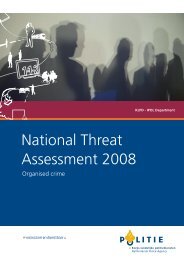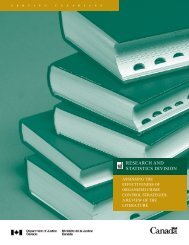Integrating Refugee and Asylum-seeking Children - Center for the ...
Integrating Refugee and Asylum-seeking Children - Center for the ...
Integrating Refugee and Asylum-seeking Children - Center for the ...
Create successful ePaper yourself
Turn your PDF publications into a flip-book with our unique Google optimized e-Paper software.
comparative report: educational integration of refugee <strong>and</strong> asylum-<strong>seeking</strong> 45<br />
3.3. human rights approach<br />
Education has <strong>for</strong>mally been recognised as a<br />
human right since <strong>the</strong> adoption of <strong>the</strong> Universal<br />
Declaration of Human Rights in 1948. This has<br />
since been reaffirmed in a number of significant<br />
human rights treaties, such as <strong>the</strong> Convention<br />
against Discrimination in Education (1960) <strong>and</strong> <strong>the</strong><br />
International Covenant on Economic, Social <strong>and</strong><br />
Cultural Rights (1966). These treaties established an<br />
entitlement to free compulsory primary education<br />
<strong>for</strong> all children. 25<br />
The human rights based approach was developed<br />
by <strong>the</strong> UN <strong>and</strong> is applied by its agencies to<br />
education, health, employment, etc. Some of<br />
its principles are particularly relevant to <strong>the</strong><br />
educational integration of RASC: universality,<br />
inalienability, equality <strong>and</strong> non-discrimination. A<br />
person cannot voluntarily give up <strong>the</strong>ir human<br />
rights; nor can o<strong>the</strong>rs take <strong>the</strong>m away. All human<br />
beings throughout <strong>the</strong> world are entitled to <strong>the</strong>se<br />
rights without discrimination of any kind, be it<br />
on <strong>the</strong> basis of race, colour, ethnicity, language,<br />
religion, national or social origin, birth or o<strong>the</strong>r<br />
status. 26 This is based on <strong>the</strong> idea of human<br />
development exp<strong>and</strong>ing people’s choices, with<br />
education being one of its three main pillars.<br />
The human development paradigm does not<br />
regard people as passive beneficiaries of economic<br />
<strong>and</strong> social activities. People must become active<br />
agents of social change. This implies opportunities<br />
<strong>for</strong> participation, empowerment, <strong>and</strong> access to<br />
in<strong>for</strong>mation. 27 The human rights based approach is<br />
an alternative to <strong>the</strong> needs-based or service-delivery<br />
approach. 28 People are recognised as key players in<br />
<strong>the</strong>ir own development, ra<strong>the</strong>r than passive recipients<br />
of commodities <strong>and</strong> services (UN 2003).<br />
The human rights approach is most clearly set out<br />
by <strong>the</strong> authors of <strong>the</strong> reports on Germany <strong>and</strong><br />
Austria:<br />
“Human rights highlight <strong>the</strong> empowerment of <strong>the</strong><br />
right-holder – here: child refugee <strong>and</strong> asylum<strong>seeking</strong><br />
children – <strong>and</strong> <strong>the</strong> accountability of dutybearers<br />
– here: primarily <strong>the</strong> government, with its<br />
relevant authorities in areas such as asylum <strong>and</strong><br />
migration, education, social assistance <strong>and</strong> child<br />
<strong>and</strong> youth welfare services.” 29<br />
This thorough <strong>and</strong> elaborate definition demonstrates<br />
<strong>the</strong> high normative pathos of <strong>the</strong> human rights<br />
approach. The integration conceived by <strong>the</strong> human<br />
rights perspective is extremely ambitious <strong>and</strong><br />
mobilises several o<strong>the</strong>r politico-normative categories,<br />
such as equality, non-discrimination, participation,<br />
empowerment <strong>and</strong> accountability.<br />
Most countries mix elements, practices, experiences<br />
<strong>and</strong> experiments inspired or imported by one or<br />
<strong>the</strong> o<strong>the</strong>r of <strong>the</strong> main models.<br />
The diachronic analysis is as eloquent as <strong>the</strong><br />
typological one. It shows that policies are not<br />
crystallised models; <strong>the</strong> same countries can shift<br />
from one conception of integration to ano<strong>the</strong>r,<br />
sometimes <strong>the</strong> opposite one. The Dutch report is<br />
<strong>the</strong> most explicit concerning this. Three stages are<br />
distinguished: 30<br />
1. Initially, Dutch policy-makers assumed that<br />
migrants’ stay would be temporary <strong>and</strong> did not<br />
encourage any <strong>for</strong>m of integration.<br />
2. Policies introduced in 1983 encouraged immigrants<br />
to integrate while retaining <strong>the</strong>ir own cultural<br />
identity, <strong>and</strong> set up special programmes to<br />
improve educational opportunities <strong>and</strong> increase<br />
25 UNICEF <strong>and</strong> UNESCO (2007), A Human Rights-Based Approach to Education <strong>for</strong> All – A Framework <strong>for</strong> <strong>the</strong> Realization of <strong>Children</strong>’s<br />
Right to Education <strong>and</strong> Rights within Education. UNICEF/UNESCO, 2007. Available at: http://unesdoc.unesco.org/images/0015/<br />
001548/154861e.pdf, p. 7.<br />
26 UN (2003), The Human Rights-Based Approach to Development Cooperation: Towards a common underst<strong>and</strong>ing among UN<br />
agencies, Report of The Second Interagency Workshop on Implementing a Human Rights-based Approach in <strong>the</strong> Context of UN<br />
Re<strong>for</strong>m. Stam<strong>for</strong>d: UN, available at: http://hrbaportal.org/?page_id=2127.<br />
27 Fukuda-Parr, Sakiko <strong>and</strong> A.K. Shiva Kumar (eds.) (2005) Human Development: concepts, measures <strong>and</strong> policies <strong>for</strong> a development<br />
paradigm. New York: Ox<strong>for</strong>d University Press.<br />
28 UNICEF <strong>and</strong> UNESCO (2007), A Human Rights-Based Approach to Education <strong>for</strong> All – A Framework <strong>for</strong> <strong>the</strong> Realization of <strong>Children</strong>’s<br />
Right to Education <strong>and</strong> Rights within Education. UNICEF/UNESCO, 2007. Available at: http://unesdoc.unesco.org/images/0015/<br />
001548/154861e.pdf, p. 9.<br />
29 Country Report: Germany.<br />
30 In <strong>the</strong> first phase, <strong>the</strong>se policies targeted mostly Turkish <strong>and</strong> Moroccan ‘guest workers’, but <strong>the</strong> policy analysis has a broader<br />
relevance.








